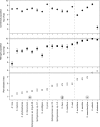Protection of Arabidopsis thaliana against leaf-pathogenic Pseudomonas syringae by Sphingomonas strains in a controlled model system
- PMID: 21421777
- PMCID: PMC3126462
- DOI: 10.1128/AEM.00133-11
Protection of Arabidopsis thaliana against leaf-pathogenic Pseudomonas syringae by Sphingomonas strains in a controlled model system
Abstract
Diverse bacterial taxa live in association with plants without causing deleterious effects. Previous analyses of phyllosphere communities revealed the predominance of few bacterial genera on healthy dicotyl plants, provoking the question of whether these commensals play a particular role in plant protection. Here, we tested two of them, Methylobacterium and Sphingomonas, with respect to their ability to diminish disease symptom formation and the proliferation of the foliar plant pathogen Pseudomonas syringae pv. tomato DC3000 on Arabidopsis thaliana. Plants were grown under gnotobiotic conditions in the absence or presence of the potential antagonists and then challenged with the pathogen. No effect of Methylobacterium strains on disease development was observed. However, members of the genus Sphingomonas showed a striking plant-protective effect by suppressing disease symptoms and diminishing pathogen growth. A survey of different Sphingomonas strains revealed that most plant isolates protected A. thaliana plants from developing severe disease symptoms. This was not true for Sphingomonas strains isolated from air, dust, or water, even when they reached cell densities in the phyllosphere comparable to those of the plant isolates. This suggests that plant protection is common among plant-colonizing Sphingomonas spp. but is not a general trait conserved within the genus Sphingomonas. The carbon source profiling of representative isolates revealed differences between protecting and nonprotecting strains, suggesting that substrate competition plays a role in plant protection by Sphingomonas. However, other mechanisms cannot be excluded at this time. In conclusion, the ability to protect plants as shown here in a model system may be an unexplored, common trait of indigenous Sphingomonas spp. and may be of relevance under natural conditions.
Figures






References
-
- Abanda-Nkpwatt D., Müsch M., Tschiersch J., Boettner M., Schwab W. 2006. Molecular interaction between Methylobacterium extorquens and seedlings: growth promotion, methanol consumption, and localization of the methanol emission site. J. Exp. Bot. 57:4025–4032 - PubMed
-
- Adhikari T. B., Joseph C. M., Yang G. P., Phillips D. A., Nelson L. M. 2001. Evaluation of bacteria isolated from rice for plant growth promotion and biological control of seedling disease of rice. Can. J. Microbiol. 47:916–924 - PubMed
-
- Boureau T., Routtu J., Roine E., Taira S., Romantschuk M. 2002. Localization of hrpA-induced Pseudomonas syringae pv. tomato DC3000 in infected tomato leaves. Mol. Plant Pathol. 3:451–460 - PubMed
-
- Buonaurio R., et al. 2002. Sphingomonas melonis sp. nov., a novel pathogen that causes brown spots on yellow Spanish melon fruits. Int. J. Syst. Evol. Microbiol. 52:2081–2087 - PubMed
Publication types
MeSH terms
Substances
Associated data
- Actions
- Actions
- Actions
- Actions
LinkOut - more resources
Full Text Sources
Other Literature Sources
Molecular Biology Databases
Miscellaneous

